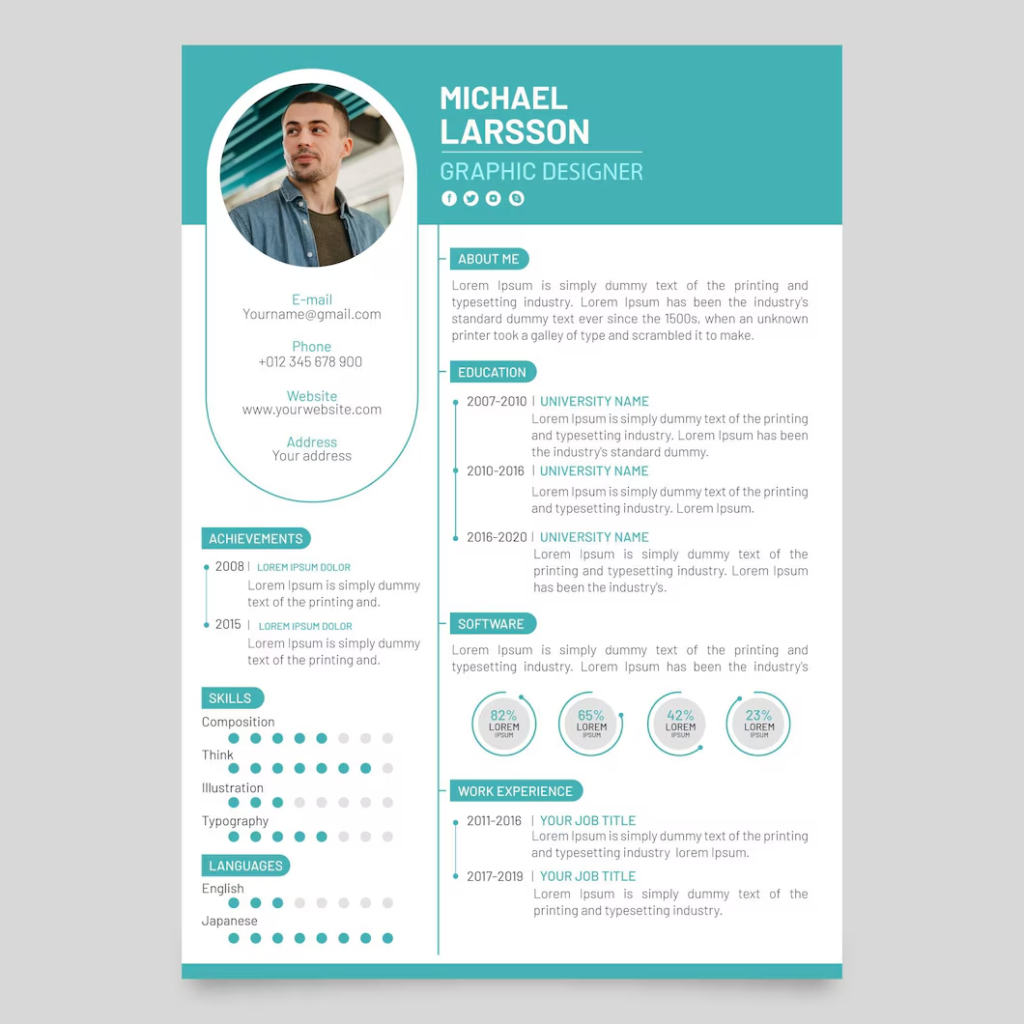Key Takeaways
- Stay ahead with modern formats: Adapt to 2024’s resume trends, emphasizing visual appeal and keyword optimization for better visibility.
- Mitigate bias, foster inclusivity: Implement strategies to ensure fair evaluations, leveraging technology and standardized criteria to promote diversity.
- Provide actionable feedback: Enhance candidate experience by offering personalized insights and constructive suggestions for resume improvement.
In today’s fiercely competitive job market, the ability to discern exceptional talent from a sea of applicants is a skill coveted by every hiring professional.
As we step into 2024, the landscape of resume and CV reviewing has evolved, demanding a nuanced understanding of industry trends, technological advancements, and the ever-changing preferences of employers.
Whether you’re a seasoned HR specialist, a diligent recruiter, or a hiring manager navigating the maze of candidate profiles, the importance of mastering the art of resume and CV review cannot be overstated.

It’s not merely about scanning through a document; it’s about delving deep into the intricacies of an individual’s professional journey, deciphering their potential, and discerning the perfect fit for your organization.
In this comprehensive guide, we embark on a journey to equip you with the tools, techniques, and insights needed to review resumes and CVs like a seasoned professional in 2024 and beyond.
From understanding the subtle nuances of modern resume formats to leveraging cutting-edge technology for streamlined evaluations, every aspect of the review process will be dissected and illuminated.
But first, let’s address the elephant in the room: why does mastering the art of resume and CV review matter now more than ever?
In an era where talent acquisition is not just about filling vacancies but about curating a workforce that drives innovation and fosters growth, the stakes have never been higher.
A single oversight in the review process could mean overlooking a diamond in the rough or, conversely, unwittingly inviting underqualified candidates into your talent pool, leading to costly hiring mistakes.
Moreover, with the global shift towards remote work and digital recruitment processes, the dynamics of resume and CV reviewing have undergone a tectonic shift.
What worked yesterday may no longer suffice today. As such, staying abreast of the latest trends, tools, and best practices is imperative for staying ahead in the game.
Throughout this guide, we’ll delve into the intricacies of modern resume and CV evaluation, from setting criteria tailored to your organization’s needs to conducting fair and bias-free assessments.
We’ll explore the role of technology in revolutionizing the review process, while also emphasizing the importance of human judgment and intuition in discerning the intangible qualities that make a candidate truly exceptional.
Whether you’re a seasoned HR professional seeking to refine your skills or a novice recruiter eager to learn the ropes, this guide promises to be your beacon of light in the often murky waters of talent acquisition.
So, buckle up and prepare to embark on a transformative journey towards becoming a master of resume and CV evaluation in 2024 and beyond.
Your next star hire could be just a few pages away.
Before we venture further into this article, we like to share who we are and what we do.
About 9cv9
9cv9 is a business tech startup based in Singapore and Asia, with a strong presence all over the world.
With over eight years of startup and business experience, and being highly involved in connecting with thousands of companies and startups, the 9cv9 team has listed some important learning points in this overview of How to Review Resumes and CVs Like a Pro in 2024.
If your company needs recruitment and headhunting services to hire top-quality employees, you can use 9cv9 headhunting and recruitment services to hire top talents and candidates. Find out more here, or send over an email to [email protected].
Or just post 1 free job posting here at 9cv9 Hiring Portal in under 10 minutes.
How to Review Resumes and CVs Like a Pro in 2024
- Understanding Modern Resume and CV Formats
- Setting Criteria for Evaluation
- Leveraging Technology in Review Processes
- Techniques for Comprehensive Review
- Common Red Flags and How to Address Them
- Conducting Fair and Bias-Free Evaluations
- Providing Constructive Feedback
- Streamlining the Review Process
1. Understanding Modern Resume and CV Formats
In the fast-paced world of recruitment, staying updated with the latest trends and formats is essential for effective resume and CV evaluation.
Here, we delve into the intricacies of modern resume and CV formats, dissecting their elements and highlighting key considerations for review.
The Distinction Between Resumes and CVs
- Resumes: Typically concise documents, resumes are tailored to specific job applications, focusing on relevant skills, experiences, and achievements.
- Example: A marketing professional’s resume may emphasize campaign management, digital marketing skills, and analytics expertise.
- CVs (Curriculum Vitae): More comprehensive than resumes, CVs provide a detailed overview of an individual’s academic and professional history, including publications, presentations, and research.
- Example: An academic CV for a professor might include sections on teaching experience, research projects, and academic publications.

Current Trends in Resume/CV Formatting
- Visual Appeal: Employers increasingly value visually appealing resumes/CVs that are easy to scan and visually engaging.
- Example: Infographic resumes incorporating graphics and charts to highlight key achievements and skills.
- Keyword Optimization: Incorporating relevant keywords from job descriptions improves visibility and ensures alignment with applicant tracking systems (ATS).
- Example: A software engineer’s resume might include keywords like “Python programming,” “full-stack development,” and “agile methodology.”
- Customization: Tailoring resumes/CVs to specific job roles and industries demonstrates attentiveness and relevance.
- Example: A candidate applying for a customer service position may emphasize communication skills and problem-solving abilities.
Key Elements to Look for in a Modern Resume/CV
- Professional Summary or Objective: A concise overview of the candidate’s skills, experiences, and career goals.
- Example: “Results-driven marketing professional with 5+ years of experience in brand management and digital marketing. Seeking to leverage expertise in driving customer engagement and revenue growth.”
- Experience Section: Detailed accounts of the candidate’s relevant work experiences, including job titles, companies, and key achievements.
- Example: “Increased website traffic by 30% through the implementation of SEO strategies and content optimization.”
- Skills and Qualifications: A comprehensive list of skills, competencies, and certifications relevant to the job.
- Example: “Proficient in Adobe Creative Suite, Google Analytics, and social media management tools.”
Adapting to Industry-Specific Standards
- Creative Industries: Resumes/CVs in creative fields often prioritize visual elements and portfolio showcases.
- Example: Graphic designers may include links to their online portfolios showcasing design projects.
- Technical Fields: Emphasis on technical skills and certifications is prominent in resumes/CVs for IT, engineering, and scientific roles.
- Example: Software developers may list programming languages, frameworks, and tools they are proficient in.
- Academic and Research: CVs for academic positions highlight publications, grants, conference presentations, and teaching experience.
- Example: A research scientist’s CV may include a list of peer-reviewed publications and research grants awarded.
Incorporating Multimedia and Interactive Elements
- Video Resumes: Candidates may supplement traditional resumes/CVs with short video introductions to showcase their personality and communication skills.
- Example: A sales professional might create a video resume highlighting their sales achievements and customer interaction abilities.
- Online Portfolios: Links to personal websites, LinkedIn profiles, or online portfolios provide additional insights into the candidate’s work.
- Example: A graphic designer may include a link to their website featuring a curated collection of design projects and client testimonials.
Understanding modern resume and CV formats is paramount for effective candidate evaluation in today’s competitive job market.
By staying abreast of current trends, adapting to industry-specific standards, and leveraging multimedia elements, hiring professionals can ensure they’re equipped to identify top talent and make informed hiring decisions.
2. Setting Criteria for Evaluation
Establishing clear and relevant criteria for evaluating resumes and CVs is fundamental to the recruitment process.
By defining specific parameters, hiring professionals can effectively assess candidates’ qualifications, experiences, and suitability for the role.
Here, we explore the process of setting criteria for evaluation and provide actionable insights for refining your approach.
Identifying Essential Skills and Qualifications
- Job Description Alignment: Ensure that the criteria align closely with the requirements outlined in the job description.
- Example: For a software developer position requiring proficiency in Python and Django, criteria should include demonstrable experience with these technologies.
- Core Competencies: Identify essential skills and competencies that are non-negotiable for success in the role.
- Example: A customer service role may prioritize communication skills, problem-solving abilities, and empathy.
- Technical Proficiency: Specify the level of expertise required in relevant technical tools, software, and systems.
- Example: A data analyst position may require proficiency in SQL, data visualization tools like Tableau, and statistical analysis software such as R or Python.
Establishing Company-Specific Requirements
- Cultural Fit: Define criteria related to cultural fit, values alignment, and organizational ethos.
- Example: Criteria may include attributes such as adaptability, collaboration, and a growth mindset, reflecting the company’s culture.
- Mission and Vision Alignment: Assess how well candidates’ experiences and aspirations align with the company’s mission and long-term vision.
- Example: A candidate who demonstrates a passion for sustainability may be a good fit for a company committed to environmental stewardship.
- Future Growth Potential: Consider criteria related to candidates’ potential for growth, leadership qualities, and adaptability to evolving roles.
- Example: Criteria may include evidence of continuous learning, leadership experiences, and a track record of taking on increasing levels of responsibility.
Incorporating Diversity, Equity, and Inclusion Considerations
- Diverse Perspectives: Prioritize criteria that promote diversity of thought, backgrounds, and experiences.
- Example: Criteria may include experiences working with diverse teams, cultural competency, and a commitment to fostering an inclusive work environment.
- Equity and Accessibility: Ensure that evaluation criteria are equitable and accessible to candidates from diverse backgrounds.
- Example: Criteria should not inadvertently disadvantage candidates based on factors such as socio-economic status, educational background, or demographic characteristics.
- Inclusive Language: Use inclusive language in the criteria to signal the organization’s commitment to diversity and inclusion.
- Example: Instead of specifying “5 years of managerial experience,” consider using language like “demonstrated leadership experience” to encompass a broader range of experiences.
Setting criteria for evaluating resumes and CVs is a strategic process that requires careful consideration of the job requirements, company culture, and diversity, equity, and inclusion principles.
By aligning criteria with the job description, defining company-specific requirements, and incorporating diversity considerations, hiring professionals can ensure a fair and thorough evaluation process that identifies top talent and fosters an inclusive workplace culture.
3. Leveraging Technology in Review Processes
In the digital age, technology has revolutionized the way resumes and CVs are reviewed, offering powerful tools to streamline the evaluation process and enhance decision-making.
Here, we explore the various ways in which technology can be leveraged to optimize resume and CV review processes, along with relevant examples to illustrate their effectiveness.
Utilizing Applicant Tracking Systems (ATS)
- Automated Screening: ATS platforms use algorithms to scan resumes/CVs for keywords, qualifications, and relevant experience, allowing recruiters to quickly identify top candidates.
- Example: An ATS may automatically filter out candidates who do not meet minimum qualifications, such as years of experience or specific certifications.
- Streamlined Workflow: ATS systems centralize candidate data, facilitate collaboration among hiring team members, and track candidate progress throughout the recruitment process.
- Example: Recruiters can use ATS dashboards to review candidate profiles, schedule interviews, and communicate with team members seamlessly.
- Data Analysis: ATS analytics provide valuable insights into recruitment metrics, including candidate sources, time-to-fill, and conversion rates, enabling data-driven decision-making.
- Example: HR managers can analyze ATS reports to identify bottlenecks in the hiring process and optimize recruitment strategies accordingly.
Implementing AI Tools for Initial Screening
- Resume Parsing: AI-powered resume parsing tools extract relevant information from resumes/CVs, such as education, work experience, and skills, saving time and minimizing manual data entry.
- Example: A resume parsing tool may automatically populate candidate profiles in an ATS with information extracted from resumes, reducing administrative burden.
- Natural Language Processing (NLP): NLP algorithms analyze the content and context of resumes/CVs, enabling more sophisticated keyword matching and semantic analysis.
- Example: NLP algorithms can identify synonyms, acronyms, and variations of keywords to improve the accuracy of candidate matching.
- Predictive Analytics: AI algorithms can analyze historical hiring data to predict candidate success and fit based on factors such as past performance, skills, and cultural fit.
- Example: Predictive analytics tools may recommend candidates who closely match the profiles of successful hires in similar roles within the organization.

Pros and Cons of Automated Resume/CV Review Processes
- Efficiency: Automated review processes save time and resources by quickly filtering out unqualified candidates and prioritizing those who best match the job requirements.
- Example: A company receiving hundreds of applications for a single position can use automated screening to efficiently narrow down the candidate pool.
- Bias Mitigation: AI algorithms can help mitigate unconscious bias by focusing solely on objective criteria and reducing human subjectivity in the initial screening process.
- Example: An AI-powered screening tool does not factor in demographic information such as gender or ethnicity, reducing the risk of bias in candidate selection.
- Limitations: Automated systems may overlook qualified candidates who do not meet specific keyword criteria or have unconventional career paths that do not fit traditional templates.
- Example: A talented candidate with transferable skills from a non-traditional background may be overlooked by an ATS that prioritizes specific qualifications.
- User Experience: Candidates may perceive automated screening processes as impersonal or unfair, leading to a negative candidate experience and potential damage to the employer brand.
- Example: A candidate who receives an automated rejection email without any personalized feedback may feel disheartened and disengaged from the hiring process.
Technology has become an indispensable tool in modern resume and CV review processes, offering automation, efficiency, and data-driven insights to enhance decision-making.
By leveraging ATS platforms, AI tools, and predictive analytics, organizations can streamline recruitment workflows, mitigate bias, and identify top talent more effectively.
However, it’s essential to strike a balance between automation and human judgment, ensuring that technology complements rather than replaces the expertise of hiring professionals.
4. Techniques for Comprehensive Review
Mastering the art of comprehensive resume and CV review is crucial for identifying the most qualified candidates and making informed hiring decisions.
Here, we delve into a variety of techniques that hiring professionals can employ to conduct thorough evaluations, ensuring that no stone is left unturned in the search for top talent.
Structural Analysis: Layout, Organization, and Readability
- Visual Appeal: Assess the overall layout and design of the resume/CV, paying attention to aesthetics, readability, and consistency.
- Example: A well-organized resume with clear section headings, bullet points, and appropriate spacing enhances readability and professionalism.
- Section Alignment: Review the alignment of key sections such as education, work experience, skills, and achievements, ensuring they are presented in a logical and easy-to-follow sequence.
- Example: A candidate’s work experience section should list positions in reverse chronological order, with consistent formatting and dates.
- Typography and Formatting: Evaluate the use of fonts, font sizes, and formatting styles to ensure consistency and visual harmony throughout the document.
- Example: Avoid excessive use of bold, italic, or underlined text, which can distract from the content and detract from readability.
For fast and quick creation of CVs and Resumes, you can try UrbanCV, the world’s most modern CV builder.
Content Assessment: Evaluating Accomplishments, Experiences, and Qualifications
- Quantifiable Achievements: Look for specific, measurable achievements and outcomes that demonstrate the candidate’s impact and contributions in previous roles.
- Example: “Increased sales revenue by 20% within six months through the implementation of targeted marketing campaigns.”
- Relevance to Job Requirements: Assess the relevance of the candidate’s experiences, skills, and qualifications to the specific requirements of the job.
- Example: For a project management role, prioritize candidates with demonstrated experience in leading cross-functional teams, managing budgets, and delivering projects on time and within scope.
- Consistency and Accuracy: Verify the accuracy of information presented in the resume/CV, including job titles, dates of employment, and educational credentials.
- Example: Cross-reference information provided in the resume/CV with online profiles such as LinkedIn to ensure consistency and authenticity.
Language and Tone Evaluation: Identifying Professionalism and Communication Skills
- Clarity and Conciseness: Assess the clarity and conciseness of language used in the resume/CV, avoiding jargon, clichés, and unnecessary verbosity.
- Example: Effective communication skills are demonstrated through clear, concise descriptions of job responsibilities, achievements, and qualifications.
- Professionalism and Tone: Evaluate the overall tone and professionalism conveyed in the resume/CV, including language choice, tone of voice, and attention to detail.
- Example: Professionalism is reflected in the use of formal language, proper grammar and punctuation, and adherence to industry standards.
- Attention to Detail: Look for evidence of attention to detail, thoroughness, and accuracy in the presentation of information, indicating the candidate’s commitment to quality.
- Example: Typos, grammatical errors, and formatting inconsistencies may signal a lack of attention to detail and detract from the overall impression of professionalism.
Comprehensive review techniques are essential for evaluating resumes and CVs effectively, enabling hiring professionals to identify the most qualified candidates and make informed hiring decisions.
By conducting structural analysis, content assessment, and language and tone evaluation, recruiters can gain valuable insights into candidates’ qualifications, experiences, and communication skills.
These techniques, when combined with industry-specific knowledge and best practices, empower hiring professionals to build high-performing teams and drive organizational success.
5. Common Red Flags and How to Address Them
Identifying red flags in resumes and CVs is essential for avoiding costly hiring mistakes and ensuring that the selected candidates are the best fit for the role and the organization.
In this section, we’ll explore some common red flags that recruiters may encounter during the review process and provide strategies for addressing them effectively.
Discrepancies and Gaps in Employment History
- Unexplained Gaps: Look for unexplained periods of unemployment or absence from the workforce, which may indicate issues such as job hopping, termination, or personal challenges.
- Example: A candidate’s resume shows a six-month gap between job positions with no explanation provided.
- Frequent Job Changes: Evaluate the frequency of job changes and short tenures, as excessive turnover may raise concerns about the candidate’s stability and commitment.
- Example: A candidate’s resume lists five different job positions within the past two years, suggesting a pattern of job hopping.
Overly Generic or Vague Language
- Lack of Specificity: Pay attention to vague or generic language that lacks concrete details or measurable achievements, as it may indicate a lack of depth or substance.
- Example: A candidate’s resume includes phrases like “responsible for various tasks” or “contributed to the success of the team” without providing specific examples or outcomes.
- Clichés and Buzzwords: Be cautious of resumes/CVs filled with clichés, buzzwords, or industry jargon, as they may mask a lack of originality or genuine accomplishments.
- Example: A candidate describes themselves as a “dynamic team player” or a “results-driven professional” without providing evidence to support these claims.
Lack of Relevant Experience or Qualifications
- Misalignment with Job Requirements: Assess whether the candidate’s skills, experiences, and qualifications align with the specific requirements outlined in the job description.
- Example: A candidate applying for a senior management position lacks the required leadership experience or strategic vision mentioned in the job posting.
- Overqualification or Underqualification: Consider whether the candidate’s level of experience and qualifications is appropriate for the role, avoiding candidates who are either overqualified or underqualified.
- Example: A candidate with a Ph.D. in chemistry applies for an entry-level laboratory technician position, raising questions about their long-term commitment and career goals.
Addressing Red Flags
- Seek Clarification: Reach out to the candidate for clarification or additional information regarding any discrepancies or gaps in their resume/CV.
- Example: Contact the candidate to inquire about the reasons for a gap in employment or to verify the accuracy of their job titles and responsibilities.
- Conduct Thorough Interviews: Use interviews as an opportunity to probe deeper into areas of concern and assess the candidate’s explanations, problem-solving skills, and cultural fit.
- Example: During the interview, ask the candidate to elaborate on their experiences, achievements, and career progression, seeking evidence to validate their claims.
- Reference Checks: Conduct reference checks with previous employers or colleagues to verify the candidate’s work history, performance, and qualifications.
- Example: Contact references provided by the candidate to gather insights into their strengths, weaknesses, and suitability for the role.
Identifying and addressing common red flags in resumes and CVs is crucial for making informed hiring decisions and selecting candidates who are the best fit for the role and the organization.
By recognizing discrepancies and gaps in employment history, addressing vague or generic language, and assessing the candidate’s alignment with job requirements, recruiters can minimize the risk of hiring mistakes and build high-performing teams.
Through proactive communication, thorough interviews, and diligent reference checks, recruiters can gather the necessary information to validate candidates’ qualifications and ensure a successful hiring outcome.
6. Conducting Fair and Bias-Free Evaluations
Ensuring fairness and mitigating bias in the resume and CV evaluation process is paramount for building diverse and inclusive teams.
In this section, we’ll explore strategies and techniques to conduct fair and bias-free evaluations, along with practical examples to illustrate their implementation.
Implementing Standardized Evaluation Criteria
- Objective Metrics: Define clear and objective criteria for evaluating resumes and CVs, focusing on qualifications, skills, and experiences relevant to the job role.
- Example: Standardized evaluation criteria may include specific job requirements such as years of experience, technical proficiency, and industry certifications.
- Rubric Development: Create evaluation rubrics or scoring systems to provide a structured framework for assessing candidates consistently and objectively.
- Example: A rubric may assign scores based on criteria such as relevance of experience, depth of skills, and clarity of communication.
Mitigating Unconscious Bias
- Awareness Training: Provide training and awareness programs to educate hiring professionals about unconscious bias and its impact on decision-making.
- Example: Interactive workshops or online modules can help recruiters recognize and address biases related to gender, race, age, and other factors.
- Blind Evaluation: Implement blind evaluation techniques to remove identifying information such as name, gender, and ethnicity from resumes and CVs.
- Example: Using blind recruitment software, recruiters can anonymize candidate profiles, focusing solely on qualifications and experiences during the initial screening process.
Promoting Diversity and Inclusion
- Diverse Hiring Panels: Ensure diversity within hiring panels to bring diverse perspectives and mitigate biases inherent in homogeneous decision-making.
- Example: A hiring panel comprising members from different backgrounds, genders, and experiences can offer a more balanced assessment of candidates.
- Inclusive Language: Use inclusive language in job postings, communications, and evaluations to signal a commitment to diversity and inclusion.
- Example: Avoid gendered language and stereotypes in job descriptions and evaluations, using neutral terms that appeal to a diverse range of candidates.
Leveraging Technology for Bias Mitigation
- AI-driven Tools: Use AI-driven tools and algorithms to detect and mitigate biases in resume and CV evaluation processes.
- Example: AI software can analyze language patterns and identify biased language or stereotypes, prompting recruiters to reconsider their evaluations.
- Data-driven Insights: Leverage data analytics to monitor and analyze hiring outcomes, identifying patterns of bias and areas for improvement.
- Example: Data dashboards can track metrics such as candidate demographics, interview outcomes, and hiring decisions to identify disparities and inform diversity initiatives.
Conducting fair and bias-free evaluations is essential for building inclusive workplaces and ensuring equal opportunities for all candidates.
By implementing standardized evaluation criteria, mitigating unconscious bias, promoting diversity and inclusion, and leveraging technology for bias mitigation, recruiters can create a more equitable and merit-based hiring process.
Through ongoing training, awareness programs, and data-driven insights, organizations can foster a culture of diversity, equity, and inclusion, driving innovation and success in the workplace.
7. Providing Constructive Feedback
Offering constructive feedback to candidates is not only a professional courtesy but also a valuable opportunity to help them improve and grow in their careers.
In this section, we’ll explore effective strategies for providing constructive feedback after reviewing resumes and CVs, along with examples to illustrate their application.
Tailoring Feedback to Individual Applicants
- Personalized Insights: Provide feedback that is tailored to the specific strengths, weaknesses, and areas for improvement of each candidate.
- Example: Instead of generic feedback, such as “Your resume needs more detail,” offer specific suggestions based on the candidate’s qualifications and experiences.
- Highlighting Strengths: Acknowledge and celebrate the candidate’s achievements, skills, and qualifications, reinforcing their confidence and motivation.
- Example: “Your extensive experience in project management and proven track record of delivering successful projects demonstrate your strong leadership skills and strategic thinking.”
Offering Actionable Suggestions for Improvement
- Specific Recommendations: Offer actionable suggestions and recommendations for improving the candidate’s resume or CV, focusing on areas where they can enhance clarity, relevance, or impact.
- Example: “Consider providing more quantifiable achievements and outcomes to demonstrate the results of your contributions in previous roles.”
- Guidance on Presentation: Provide guidance on formatting, layout, and language to enhance the overall presentation and readability of the resume or CV.
- Example: “Organize your experience section in reverse chronological order to highlight your most recent and relevant roles first, followed by earlier experiences.”
Maintaining Professionalism and Respect
- Constructive Tone: Deliver feedback in a constructive and respectful manner, avoiding harsh criticism or negative language that may demotivate or discourage the candidate.
- Example: “While your resume demonstrates strong technical skills, there may be opportunities to further highlight your leadership abilities and contributions to team projects.”
- Encouraging Growth: Frame feedback as an opportunity for growth and development, emphasizing the candidate’s potential for improvement and future success.
- Example: “By refining your resume to better showcase your accomplishments and qualifications, you can enhance your competitiveness in the job market and attract more opportunities.”
Timely and Transparent Communication
- Prompt Response: Provide feedback in a timely manner, ideally soon after reviewing the candidate’s resume or CV, to demonstrate professionalism and respect for their time.
- Example: Aim to send feedback within a few days of receiving the candidate’s application, while the details of their resume are still fresh in your mind.
- Transparency: Be transparent about the reasons for your feedback and the criteria used to evaluate the candidate’s application, fostering trust and transparency in the process.
- Example: “I noticed that your resume lacks specific examples of your accomplishments in previous roles, which makes it challenging for employers to assess your potential impact.”
Providing constructive feedback to candidates is an essential aspect of the recruitment process, allowing them to learn, grow, and improve their chances of success.
By tailoring feedback to individual applicants, offering actionable suggestions for improvement, maintaining professionalism and respect, and communicating transparently and promptly, recruiters can empower candidates to enhance their resumes and CVs and position themselves more competitively in the job market.
Through constructive feedback, recruiters play a pivotal role in supporting candidates’ professional development and helping them achieve their career goals.
8. Streamlining the Review Process
Efficiency and effectiveness are key in the resume and CV review process, especially when handling large volumes of applications.
Streamlining the review process not only saves time but also ensures that the most qualified candidates are identified promptly.
Here, we’ll explore various strategies and techniques to streamline the review process for optimal results.
Developing Efficient Review Workflows
- Establish Clear Procedures: Define clear review procedures and workflows to ensure consistency and accountability among team members.
- Example: Designate specific roles and responsibilities for each team member involved in the review process, such as primary reviewers, secondary reviewers, and decision-makers.
- Utilize Technology: Leverage applicant tracking systems (ATS) and resume parsing tools to automate routine tasks and streamline the flow of candidate information.
- Example: Use ATS features such as bulk actions, email templates, and scheduling tools to expedite communication and decision-making.
- Set Realistic Timelines: Establish realistic timelines and deadlines for each stage of the review process to maintain momentum and avoid bottlenecks.
- Example: Create a timeline with clear milestones and deadlines for resume review, candidate screening, interview scheduling, and final selection.
Collaboration Techniques for Team-Based Reviews
- Regular Communication: Foster open and transparent communication among team members to facilitate collaboration, knowledge sharing, and decision-making.
- Example: Schedule regular team meetings or check-ins to discuss progress, share insights, and address any challenges or concerns.
- Centralized Documentation: Use centralized document repositories or collaboration platforms to store resumes, CVs, feedback, and evaluation criteria for easy access and reference.
- Example: Create shared folders or documents on platforms like Google Drive or Microsoft Teams to organize and centralize review-related documents and discussions.
- Peer Review and Feedback: Encourage peer review and feedback to leverage diverse perspectives and insights from team members with different backgrounds and expertise.
- Example: Implement a peer review process where team members can provide constructive feedback on each other’s evaluations and recommendations.
Incorporating Feedback Loops for Continuous Improvement
- Post-Review Debriefs: Conduct post-review debrief sessions to reflect on the effectiveness of the review process, identify areas for improvement, and implement corrective actions.
- Example: Hold a debrief meeting after completing a round of resume reviews to discuss feedback from team members, identify common themes or patterns, and refine review criteria.
- Surveys and Feedback Forms: Gather feedback from stakeholders, including hiring managers, recruiters, and candidates, to assess their satisfaction with the review process and identify areas for enhancement.
- Example: Send out surveys or feedback forms to stakeholders after each recruitment cycle to solicit input on the efficiency, effectiveness, and fairness of the review process.
- Iterative Optimization: Continuously iterate and optimize the review process based on feedback, data analytics, and emerging best practices to enhance efficiency and effectiveness over time.
- Example: Use analytics dashboards provided by ATS platforms to track metrics such as time-to-fill, candidate conversion rates, and interviewer feedback, and use this data to inform process improvements.
Streamlining the resume and CV review process is essential for optimizing efficiency, maintaining quality, and ensuring a positive candidate experience.
By developing efficient review workflows, fostering collaboration among team members, and incorporating feedback loops for continuous improvement, recruiters can expedite the review process, identify top talent more effectively, and make informed hiring decisions.
Through a combination of technology, communication, and iterative optimization, organizations can streamline their recruitment processes to attract, assess, and hire the best candidates for their teams.
Conclusion
In the fast-paced world of recruitment, mastering the art of resume and CV review is not just a skill—it’s a strategic imperative.
As we navigate the dynamic landscape of 2024, where talent acquisition is more competitive than ever, the ability to discern exceptional candidates from the vast pool of applicants is invaluable.
Throughout this comprehensive guide, we’ve delved deep into the intricacies of modern resume and CV evaluation, equipping you with the tools, techniques, and insights needed to review resumes and CVs like a seasoned professional.
From understanding the nuances of modern resume formats to leveraging cutting-edge technology for streamlined evaluations, we’ve explored every facet of the review process.
We’ve discussed the importance of setting clear criteria for evaluation, tailoring feedback to individual candidates, and mitigating bias to ensure fairness and inclusivity in hiring practices.
By implementing standardized evaluation criteria, leveraging technology for bias mitigation, and fostering collaboration among team members, recruiters can streamline the review process and identify top talent more effectively.
Moreover, we’ve addressed common red flags and provided strategies for addressing them, ensuring that recruiters can make informed hiring decisions based on accurate and reliable information.
Whether it’s discrepancies in employment history, vague language, or lack of relevant experience, we’ve outlined actionable steps for identifying and mitigating red flags to build high-performing teams.
Additionally, we’ve emphasized the importance of providing constructive feedback to candidates, not only as a professional courtesy but also as an opportunity for growth and development.
By offering personalized insights, actionable suggestions for improvement, and maintaining professionalism and respect, recruiters can empower candidates to enhance their resumes and CVs and position themselves more competitively in the job market.
Mastering the art of resume and CV review requires a combination of expertise, technology, and a commitment to fairness and inclusivity.
By implementing the strategies and techniques outlined in this guide, recruiters can streamline their review processes, identify top talent more effectively, and contribute to the success of their organizations in 2024 and beyond.
As the recruitment landscape continues to evolve, staying adaptable, proactive, and informed will be key to staying ahead of the curve and making impactful hiring decisions.
If your company needs HR, hiring, or corporate services, you can use 9cv9 hiring and recruitment services. Book a consultation slot here, or send over an email to [email protected].
If you find this article useful, why not share it with your hiring manager and C-level suite friends and also leave a nice comment below?
We, at the 9cv9 Research Team, strive to bring the latest and most meaningful data, guides, and statistics to your doorstep.
To get access to top-quality guides, click over to 9cv9 Blog.
People Also Ask
What are the key differences between a resume and a CV?
Resumes are concise summaries of a candidate’s skills and experiences, typically tailored to specific job applications. CVs, on the other hand, are more comprehensive and include detailed information about academic achievements, publications, and professional affiliations.
How do I identify relevant keywords in resumes and CVs?
Look for keywords that align with the job description and industry standards. Pay attention to technical skills, certifications, and specific job titles mentioned in the document.
What are the best practices for formatting a resume or CV?
Ensure readability by using a clean and professional layout. Use consistent formatting for headings, bullet points, and fonts. Avoid excessive use of colors, graphics, or fancy fonts that may distract from the content.
How can I effectively assess a candidate’s qualifications?
Focus on the candidate’s relevant work experience, education, skills, and achievements. Look for quantifiable results and evidence of impact in previous roles.
How can I ensure fairness and mitigate bias in resume/CV evaluations?
Implement standardized evaluation criteria, anonymize candidate information, and provide unconscious bias training for hiring teams. Use technology to automate processes and reduce human bias.
What are some common red flags to watch out for in resumes/CVs?
Watch out for unexplained gaps in employment history, vague or generic language, and inconsistencies in job titles or dates. Be cautious of resumes/CVs that lack relevant experience or qualifications for the job.
How can I provide constructive feedback to candidates?
Offer personalized insights and actionable suggestions for improvement. Focus on strengths and provide guidance on areas for development, maintaining professionalism and respect throughout the process.
What role does technology play in streamlining the resume/CV review process?
Technology, such as applicant tracking systems (ATS) and AI tools, can automate tasks, streamline communication, and enhance data analysis. Leveraging technology can improve efficiency and effectiveness in resume/CV evaluations.
How should I handle a large volume of resumes/CVs?
Develop efficient review workflows, utilize technology for automation and organization, and foster collaboration among team members. Set clear criteria for evaluation and prioritize candidates based on job requirements.
How can I tailor my resume/CV review process to match industry-specific needs?
Understand the unique requirements and preferences of your industry, such as specific technical skills or certifications. Customize evaluation criteria and feedback based on industry standards and best practices.
What are the benefits of peer review in the resume/CV evaluation process?
Peer review encourages collaboration, provides diverse perspectives, and enhances the quality of evaluations. It can help identify blind spots, validate assessments, and ensure consistency in decision-making.
How should I handle sensitive information disclosed in resumes/CVs?
Respect candidate privacy and confidentiality by handling sensitive information with care. Limit access to sensitive data, comply with privacy regulations, and ensure secure storage and disposal of documents.
How can I keep track of candidates throughout the review process?
Use applicant tracking systems (ATS) to centralize candidate information, track progress, and streamline communication. Maintain detailed records of interactions, evaluations, and feedback for each candidate.
What should I do if I encounter a resume/CV that doesn’t meet minimum qualifications?
Consider providing constructive feedback to the candidate, offering guidance on areas for improvement. If the candidate is close to meeting qualifications, explore opportunities for skills development or additional training.
How can I ensure a positive candidate experience during the review process?
Communicate transparently, provide timely updates, and offer constructive feedback to candidates. Respect their time and effort by acknowledging receipt of their application and keeping them informed of their status throughout the process.
What strategies can I use to optimize my resume/CV review process?
Regularly assess and refine your review workflows, leverage technology for automation and efficiency, and seek feedback from stakeholders. Continuously iterate and adapt to evolving recruitment trends and best practices.
How can I evaluate the effectiveness of my resume/CV review process?
Monitor key metrics such as time-to-fill, candidate conversion rates, and interviewer feedback. Gather feedback from hiring teams, candidates, and other stakeholders to assess satisfaction and identify areas for improvement.
What are the legal considerations when reviewing resumes/CVs?
Adhere to equal employment opportunity (EEO) laws and anti-discrimination regulations. Avoid making decisions based on protected characteristics such as race, gender, age, or disability. Document evaluations and decisions to demonstrate compliance with legal requirements.
How do I handle disagreements among team members during the review process?
Encourage open dialogue and constructive feedback among team members. Facilitate discussions to address differences in opinion, clarify evaluation criteria, and reach consensus on candidate assessments.
How can I ensure that my resume/CV review process aligns with organizational goals and priorities?
Align review criteria with the company’s mission, values, and strategic objectives. Customize evaluation processes to prioritize skills and qualifications that are critical to achieving organizational success.































![Writing A Good CV [6 Tips To Improve Your CV] 6 Tips To Improve Your CV](https://blog.9cv9.com/wp-content/uploads/2020/06/2020-06-02-2-100x70.png)


